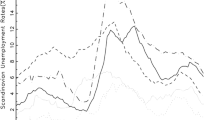Abstract
Many economic and financial time series exhibit trending behavior or non-stationarity in the mean. Leading examples are asset prices, exchange rates and the levels of macroeconomic aggregates like real GDP. An important econometric task is determining the most appropriate form of the trend in the data. For example, in ARMA modeling the data must be transformed to stationary form prior to analysis. If the data are trending, then some form of trend removal is required.
Access this chapter
Tax calculation will be finalised at checkout
Purchases are for personal use only
Preview
Unable to display preview. Download preview PDF.
Similar content being viewed by others
4.7 References
Caner, M. and L. Kilian (2001). “Size Distortions of Tests of the Null Hypothesis of Stationarity: Evidence and Implications for the PPP Debate,” Journal of International Money and Finance, 20, 639–657.
Dickey, D. and W. Fuller (1979). “Distribution of the Estimators for Autoregressive Time Series with a Unit Root,” Journal of the American Statistical Association, 74, 427–431.
Dickey, D. and W. Fuller (1981). “Likelihood Ratio Statistics for Autoregressive Time Series with a Unit Root,” Econometrica, 49, 1057–1072.
Elliot, G., T.J. Rothenberg, and J.H. Stock (1996). “Efficient Tests for an Autoregressive Unit Root,” Econometrica, 64, 813–836.
Fuller, W. (1996). Introduction to Statistical Time Series, Second Edition. John Wiley, New York.
Hamilton, J. (1994). Time Series Analysis. Princeton University Press, Princeton, NJ.
Hatanaka, T. (1995). Time-Series-Based Econometrics: Unit Roots and Co-Integration. Oxford University Press, Oxford.
Kwiatkowski, D., P.C.B. Phillips, P. Schmidt and Y. Shin (1992). “Testing the Null Hypothesis of Stationarity Against the Alternative of a Unit Root,” Journal of Econometrics, 54, 159–178.
MacKinnon, J. (1996). “Numerical Distribution Functions for Unit Root and Cointegration Tests,” Journal of Applied Econometrics, 11, 601–618.
Maddala, G.S. and I.-M. Kim (1998). Unit Roots, Cointegration and Structural Change. Oxford University Press, Oxford.
Ng, S., and P. Perron (1995). “Unit Root Tests in ARMA Models with Data-Dependent Methods for the Selection of the Truncation Lag,” Journal of the American Statistical Association, 90, 268–281.
Ng, S., and P. Perron (2001). “Lag Length Selection and the Construction of Unit Root Tests with Good Size and Power,” Econometrica, 69, 1519–1554.
Perron, P. and S. Ng. (1996). “Useful Modifications to Some Unit Root Tests with Dependent Errors and their Local Asymptotic Properties,” Review of Economic Studies, 63, 435–463.
Phillips, P.C.B. (1987). “Time Series Regression with a Unit Root,” Econometrica, 55, 227–301.
Phillips, P.C.B. and P. Perron (1988). “Testing for Unit Roots in Time Series Regression,” Biometrika, 75, 335–346.
Phillips, P.C.B. and Z. Xiao (1998). “A Primer on Unit Root Testing,” Journal of Economic Surveys, 12, 423–470.
Schwert, W. (1989). “Test for Unit Roots: A Monte Carlo Investigation,” Journal of Business and Economic Statistics, 7, 147–159.
Said, S.E. and D. Dickey (1984). “Testing for Unit Roots in Autoregressive Moving-Average Models with Unknown Order,” Biometrika, 71, 599–607.
Stock, J.H. (1994). “Units Roots, Structural Breaks and Trends,” in R.F. Engle and D.L. McFadden (eds.), Handbook of Econometrics, Volume IV. North Holland, New York.
Rights and permissions
Copyright information
© 2006 Springer Science+Business Media, Inc.
About this chapter
Cite this chapter
(2006). Unit Root Tests. In: Modeling Financial Time Series with S-PLUS®. Springer, New York, NY. https://doi.org/10.1007/978-0-387-32348-0_4
Download citation
DOI: https://doi.org/10.1007/978-0-387-32348-0_4
Publisher Name: Springer, New York, NY
Print ISBN: 978-0-387-27965-7
Online ISBN: 978-0-387-32348-0
eBook Packages: Mathematics and StatisticsMathematics and Statistics (R0)




